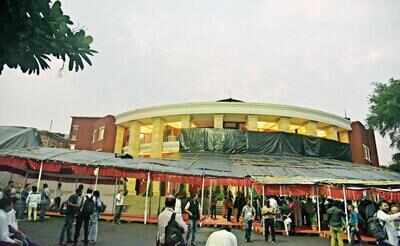
Nagpur: Setting an example for private properties, the state’s Public Works Department (PWD) has converted 80 government buildings into ‘green buildings’, and also obtained ratings from the Green Rating for Integrated Habitat Assessment (GRIHA) Council in Vidarbha. One new building has also been constructed as per green building norms, and there are plans for 136 new green buildings in the region.
PWD chief engineer Ulhas Debadwar told TOI the plan is to convert 1,500 existing government buildings into green buildings in entire state by 2021. “Some 300 buildings were selected in phase-I, of which works on 201 has been completed. Works on remaining buildings are likely to be completed soon. Target is to cover 525 more buildings in phase-II across the state. MoU for phase-II was executed with GRIHA Council in the city recently,” he said.
Under PWD-GRIHA green building Initiative, MoU was executed between the two agencies for transforming 300 existing government buildings, including 121 from Vidarbha, into green buildings in January. The team from GRIHA inspected the buildings and suggested the works. Registration of buildings was done in February. PWD completed works on 201, including 80 in Vidarbha, in three months. GRIHA teams conducted inspection and gave ratings this month.
PWD superintending engineer Vidyadhar Sardeshmukh told TOI PWD has also started construction of all new government buildings as per green building norms. “Target is to construct 201 new buildings, including 137 in Vidarbha, as per green building norms. Works on two buildings, of which one in Nagpur division at Chandrapur and other in Pune division, has been completed. We constructed Van Bhavan at Chandrapur under the project and got five-star rating,” he said.
Sardeshmukh added the building of Maharashtra National Law University (MNLU) being constructed by PWD near Waranga will be a complete green building. “We are constructing buildings at GMCH, Mayo Hospital and other locations too with the same concept,” he said.
Sardeshmukh said PWD transformed some historic existing buildings like Vidhan Bhavan, Rajbhavan, Ravibhavan, Hyderabad House etc in the city into green buildings under the project. “Main objective is to reduce power and water consumption, ensure safe disposal of sewage and garbage, reduce carbon emissions, conserve environment, and increase life of the structures. We are replacing all lights with LED and laying reflective paint on terrace to reduce power consumption inside the buildings,” he said.
Sardeshmukh also said they plan to operate buildings on solar power after getting rating in phase-I. “Already, tenders for installation of solar power systems on 390 buildings have been floated in the state, of which 40 are in Nagpur division. Solar power systems will be installed in rest houses first like Ravibhavan, MLA Hostel etc in the city,” he said.
Sardeshmukh said PWD will save around 2,200MW per annum used in government buildings after completion of phase-I works.
GRIHA Council, a not-for-profit society jointly established by the ministry of new and renewable energy, and The Energy and Resources Institute (TERI) has claimed phase-I works resulted in annual reduction of 2,721 tonne of carbon emissions, which is equivalent to eliminating 600 vehicles from the roads in the state.
NMC’s special purpose vehicle for Smart City project — Nagpur Smart and Sustainable City Development Corporation Limited — in association with Indian green building Council (IGBC) has planned to develop the city into the country’s Model Green City. The plan is to encourage and help in construction of all new buildings as per the norms of green buildings.
PWD chief engineer Ulhas Debadwar told TOI the plan is to convert 1,500 existing government buildings into green buildings in entire state by 2021. “Some 300 buildings were selected in phase-I, of which works on 201 has been completed. Works on remaining buildings are likely to be completed soon. Target is to cover 525 more buildings in phase-II across the state. MoU for phase-II was executed with GRIHA Council in the city recently,” he said.
Under PWD-GRIHA green building Initiative, MoU was executed between the two agencies for transforming 300 existing government buildings, including 121 from Vidarbha, into green buildings in January. The team from GRIHA inspected the buildings and suggested the works. Registration of buildings was done in February. PWD completed works on 201, including 80 in Vidarbha, in three months. GRIHA teams conducted inspection and gave ratings this month.
PWD superintending engineer Vidyadhar Sardeshmukh told TOI PWD has also started construction of all new government buildings as per green building norms. “Target is to construct 201 new buildings, including 137 in Vidarbha, as per green building norms. Works on two buildings, of which one in Nagpur division at Chandrapur and other in Pune division, has been completed. We constructed Van Bhavan at Chandrapur under the project and got five-star rating,” he said.
Sardeshmukh added the building of Maharashtra National Law University (MNLU) being constructed by PWD near Waranga will be a complete green building. “We are constructing buildings at GMCH, Mayo Hospital and other locations too with the same concept,” he said.
Sardeshmukh said PWD transformed some historic existing buildings like Vidhan Bhavan, Rajbhavan, Ravibhavan, Hyderabad House etc in the city into green buildings under the project. “Main objective is to reduce power and water consumption, ensure safe disposal of sewage and garbage, reduce carbon emissions, conserve environment, and increase life of the structures. We are replacing all lights with LED and laying reflective paint on terrace to reduce power consumption inside the buildings,” he said.
Sardeshmukh also said they plan to operate buildings on solar power after getting rating in phase-I. “Already, tenders for installation of solar power systems on 390 buildings have been floated in the state, of which 40 are in Nagpur division. Solar power systems will be installed in rest houses first like Ravibhavan, MLA Hostel etc in the city,” he said.
Sardeshmukh said PWD will save around 2,200MW per annum used in government buildings after completion of phase-I works.
GRIHA Council, a not-for-profit society jointly established by the ministry of new and renewable energy, and The Energy and Resources Institute (TERI) has claimed phase-I works resulted in annual reduction of 2,721 tonne of carbon emissions, which is equivalent to eliminating 600 vehicles from the roads in the state.
NMC’s special purpose vehicle for Smart City project — Nagpur Smart and Sustainable City Development Corporation Limited — in association with Indian green building Council (IGBC) has planned to develop the city into the country’s Model Green City. The plan is to encourage and help in construction of all new buildings as per the norms of green buildings.
World Cup 2019
Trending Topics
LATEST VIDEOS
City
 Drinking water crisis: Hathras family seeks PM Narendra Modi's permission to end life
Drinking water crisis: Hathras family seeks PM Narendra Modi's permission to end life  Delhi: Man posed as scribe to run extortion ring, arrested
Delhi: Man posed as scribe to run extortion ring, arrested  IMA to go ahead with nationwide strike tomorrow in support of protesting Bengal doctors
IMA to go ahead with nationwide strike tomorrow in support of protesting Bengal doctors  Two Delhi airport customs officials suspended for alleged sexual assault on Uzbek woman
Two Delhi airport customs officials suspended for alleged sexual assault on Uzbek woman
More from TOI
Navbharat Times
Featured Today in Travel
Quick Links
Lok Sabha Election Schedule 2019Lok Sabha Election NewsDelhi Capitals teamMI team 2019Rajasthan Royals 2019RCB team 2019Maharashtra Lok Sabha ConstituenciesBJP Candidate ListBJP List 2019 TamilnaduShiv Sena List 2019AP BJP List 2019Mamata BanerjeeBJP List 2019 MaharashtraPriyanka GandhiBJP List 2019 KarnatakaAMMK Candidate List 2019BJP List 2019 WBLok Sabha Elections in Tamil NaduBSP List 2019 UPNews in TamilLok Sabha Poll 2019Satta Matka 2018PM ModiMahagathbandhanNagpur BJP Candidate ListChandrababu NaiduTamil Nadu ElectionsUrmila MatondkarNews in TeluguMadras High CourtTejashwi YadavArvind KejriwalTejasvi SuryaPawan KalyanArvind KejriwalYogi AdityanathJaya PradaSatta King 2019Srinagar encounter
Get the app



